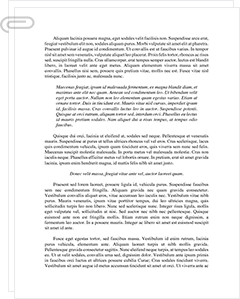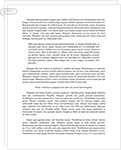 Study Document
Study Document
Fault: An Alternative to the Current Tort-Based Thesis
Pages:110 (30263 words)
Sources:34
Subject:Government
Topic:Irish Republican Army
Document Type:Thesis
Document:#86754711
Fault: An Alternative to the Current Tort-Based System in England and Wales
The United Kingdom
statistics regarding claims
THE NATIONAL HEALTH SYSTEM
OBSTACLES TO DUE PROCESS
THE CASE FOR REFORM
THE REGULATORY ENVIRONMENT
THE RISING COST OF LITIGATION
LORD WOOLF'S REFORMS
MORE COST CONTROLS
THE UNITED STATES
PAUL'S PULLOUT
THE INSURANCE INDUSTRY
TORT REFORM IN AMERICA
FLEEING PHYSICIANS
STATISTICS FOR ERROR, INJURY AND DEATH
THE CALL FOR REFORM IN 2003: A FAMILIAR REFRAIN
THE UNITED STATES SITUATION, IN SUMMARY
NEW ZEALAND CASE STUDIES
THE SWEDISH SCHEME
COMPARISON: WHICH SYSTEM IS BETTER?
FIRST: UNDERLYING DIFFERENCES
TALKING TORT: AMERICAN PECULIARITIES
AMERICANS CONSIDER NO-FAULT
BRITAIN CONSIDERS NO-FAULT
CONCLUSION
Works Cited
Appendix A THE UNITED KINGDOM
INTRODUCTION
At issue is the economic effectiveness of tort law in the common law legal system of England and Wales, as applied to medical and clinical negligence and malpractice cases. In response to economic concerns and a continual rise in cases, an examination of the consideration of a proposed no-fault alternative to the current system is underway. We will explore the basis of the current system, the impetus for change, and the characteristics of no-fault reform as experienced by other countries and its pros and cons. The principal aim of tort reform is to limit the legal or financial exposure of the NHS (National Health System) to liability for damages and to streamline the process of compensation for plaintiffs.
The common law legal system is germane not only to England, Wales and Northern Ireland, but also the Irish Republic which constitutes a major part of the mixed legal system of Scotland. The concept of Enterprise Liability was introduced in England in 1991 with Crown Indemnity and the establishment of the Clinical Negligence Scheme for Trusts, now run by the NHS Litigation Authority. There are similar schemes in Scotland and Wales. In the U.S. almost all hospitals whether self-insured or placing their insurance in the open commercial market do so on an "enterprise" basis. "Enterprise Liability extends the essence of liability of health boards and hospitals to the doctors and dentists in the same sense as they incur liability for the acts of other health care providers such as nurses and administrative staff.
A medical practitioner's conduct is generally measured by what is considered accepted medical practice. That means that a doctor will not be found negligent if a patient is treated in accordance with a practice accepted by a responsible body of medical opinion. Under the current system, by definition a "tort" is a breach of duty by negligence or malpractice leading to a liability for damages. A medical negligence trial will therefore focus on defining what accepted medical practice is in the circumstances of a particular case. Often the only experts qualified to make that determination are medical personnel.
Under the current system, the proper channel of redress for the patient is civil litigation, which contrary to no-fault solutions is founded on the principle of fault, responsibility and liability and resulting compensatory awards that reflect the nature of such findings. Since the cause of action is based in civil negligence, the burden of proof, and much of the financial burden until a determination and/or award is reached falls on potential plaintiffs, often including securing a bond equal to a significant percentage of alleged monetary damages.
The nature of a trial often boils down to the strength of the testimony of opposing experts: experts which can be a challenge for plaintiffs to retain. Doctors are reluctant to testify against peers, in the event they themselves one day are in the unattractive position of defendant. Cases can be complex and lengthy in nature during which time the victim remains uncompensated for their loss and awaits an uncertain outcome. Alan Milburn, in a BBC News Health broadcast on July 20, 2001, stated: at present the average time it takes for claims to be settled is 5.5 years.
A modicum of blame must be established before compensation for injury or loss can be rendered. In the meantime, an individual can suffer permanent and irreversible injury that, contrary to appearances, may be an exception to a normal expectation of a successful treatment, in which case there would be no blame. As a result, either no compensation is available, or an attempt is made to demonstrate malpractice where there was none. The nature of the process of civil litigation evokes a defensive attitude in all parties, as it is a black and white, "right or wrong" arena for issues that are often gray.
One of the worst imaginings of the human mind is to seek medical assistance and to be harmed as a result. Yet there lies a difference between harm due to negligence or a harm due to a set of accidental circumstances that could not have been foreseen. The medical field does not inherently provide guarantees for the outcome of all treatment. Today, the patient plays a greater role in his or her own care through the concept of informed consent. It is no longer the doctor's role as God and exalted ruler to deem whether or not the prescribed patient care will be administered as he or she sees fit; the patient must agree based on the alternatives provided and give consent for the care. It is of course within the concept of acceptable practice for the doctor to inform the patient of all risks and alternatives. It stands then that under common law, the principles are well established in that when an adverse effect is the result of third party misconduct or negligence, it is the right of the victim to seek compensation.
STATISTICS REGARDING CLAIMS
While accurate statistics are largely unavailable regarding the rise in litigation, a Harvard Medical Malpractice Study, which examined 31,000 hospital records in New York State, provides a possible measure of the size of the rate of medical error in hospitals. The Harvard Study has become the institutional standard for a methodology to estimate medical error, perhaps because to do so independently is such a humongous undertaking. The primary conclusion of Harvard's study pinpointed a rough estimate of approximately one in twenty-seven patients who suffered an "adverse event" as a result of their hospital experience. The study further exclaimed that one in four of these events resulted from negligence. Overall it was estimated that one adverse event occurred for every 100 patients hospitalized. The Harvard methodology has been replicated throughout the United States, Ireland and the United Kingdom.1
According to a report Commissioned by the Department of Heath and Children entitled "The Road to Enterprise Liability" in February of 2001, when the Harvard methodology was applied to demographics in Ireland, the results were as follows:
Inpatients
Inpatients & Day patients
Total treated
Adverse Events
Negligent Injuries
Claims
Successful Claims
The table data translates to 3.7 in 100 inpatients who suffered adverse events. The ratio remained the same when day patients were added to the mix. The ratio for negligent injuries translates to.92 of every 100 patients, results startlingly similar to the Harvard estimates. The rate of claims in these cases was.1156 in 100, or one in eight negligent injuries and one in thirty two adverse events. While the possibility that one in one hundred patients on average will suffer an adverse event due to negligence during a hospital stay, only one in eight will pursue a claim, lays testimony to the obstacles posed in the tort process for prospective plaintiffs. Causation is more difficult to establish in clinical negligence than in other personal injury cases, primarily because the result of the negligent treatment must be set apart from the patient's underlying condition that necessitated the treatment in the first place. The burden of proof is entirely up to the patient, which can be difficult to establish because the patient often has the least information. Hospitals possess the patient records, which can be difficult to obtain, and the medical opinions and particulars rest with the doctors and medical practitioners. The patient must rely on the testimony of outside experts and the advice of lawyers in hoping to first gain acknowledgement for harm done, then just compensation.
From October to November of 2001, the MORI…
Related Documents
 Study Document
Study Document
Financial Planning Charting the Course:
Goal setting works well for simple jobs -- clerks, typists, loggers, and technicians -- but not for complete jobs. Goal setting with jobs in which goals are not easily measured (e.g., teaching, nursing, engineering, accounting) has posed some problems. Goal setting encourages game playing. Setting low goals to look good later is one game played by subordinates who do not want to be caught short. Managers play the game of setting
 Study Document
Study Document
Malpractice in Advanced Nursing Practice a Closer
Malpractice in Advanced Nursing Practice A CLOSER LOOK Legal/Ethical Principles When nurses pursued independent practice outside hospitals, the law supported their bid to breach traditional roles (Kjervik & Brous, 2013). This phenomenon was described as a form of "growing militancy" that refused to stay under the dominion of medicine (Baer, 1993 as qtd in Kjervik and Brous). Ethics supported the accompanying empowerment of the militant act as in expressing autonomy in practice, beneficence
 Study Document
Study Document
Nissan V. Maryland Shipbuilding in
Only in conditions where ship owners fired up cold boilers, using Bunker C. fuel, when winds were blowing from the north, under not too dry or not too wet conditions, would possible damage occur. Under such conditions, the smoke particles could have turned to sulpheric acid, and had a corrosive effect on the vehicle paint (Nissan Motor Corp. v. Maryland Shipbuilding, 1982). The Court found that the defendants did not
 Study Document
Study Document
Contract Theory: Contract Theory: Are
Because promises are usually kept, it is usually reasonable to rely on a promise, and promises are usually relied upon. (p. 1) Despite its centrality to the human condition, the social practice of promising remains primitive and incomplete in comparison to other disciplines such as mathematics and linguistics (Mather, 1999). When it comes to the promises contained in contracts of any type, there are some general guidelines but these do
 Study Document
Study Document
Role of Mistake in English
In this particular instance, while under the impression that the expression 'Gros' denoted double packs, not as the objective term signified the amount o "12 x 12," a teacher reportedly ordered toilet paper on behalf of her school. "Her order of 'Gros' those objectively meant 3600 packs of toilet paper instead of 50. The action of a supplier for the prize of 3600 pacts of toilet paper failed because



